CHAPTER 8
SILVER CHLORIDE
GELATIN PHOTOGRAPHIC EMULSION
liquid light sensitive gelatine silver chloride emulsions given below are part of my book: chapter 8,
of PHOTOGRAPHIC SILVER EMULSIONS BOOK. formulas and directions are given here of
how to make liquid light sensitive silver chloride gelatine emulsions, of contact and enlaring speeds.

Liquid Light Sensitive Emulsions. Chloride Unwashed Positive Emulsion # 4
To make the following emulsion you do not need a darkroom! Work can be done at night away from fluorescent daylight type light
sources. Emulsion can be made at a distance of 3 meters ( 9 feet ) from an incandescent 25w ordinary white light bulb.
Place the bulb behind you so your own body Shades the working table as shown in figure below.
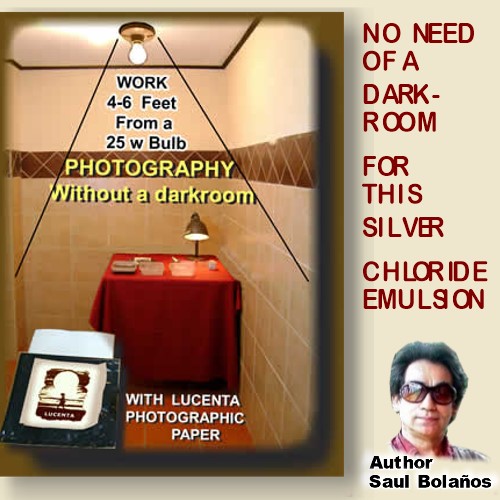 Basic Raw Material
Needed:
Basic Raw Material
Needed:
1. Gelatine
2. Silver Nitrate
3. Distilled Water
4. Ordinary Kitchen Salt
Emulsion can be mixed, made and coated at a distance of 3 meters from a 25w white light bulb, but shading the mixing
vessels with your own body as shown in figure above. Emulsion is 100 % less sensitive to light in humid form than
in dried form. It is recommended that you make this emulsion before any other emulsion given in this book. You will
know the basics of mixing chemicals, the feel of gelatine solutions, and most important also of coating the emulsion on
paper which can be done very conveniently under Very Bright Light.

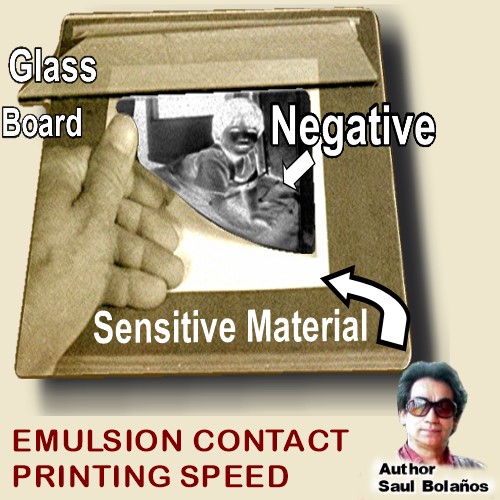
my Chloride Unwashed Positive Emulsion # 4
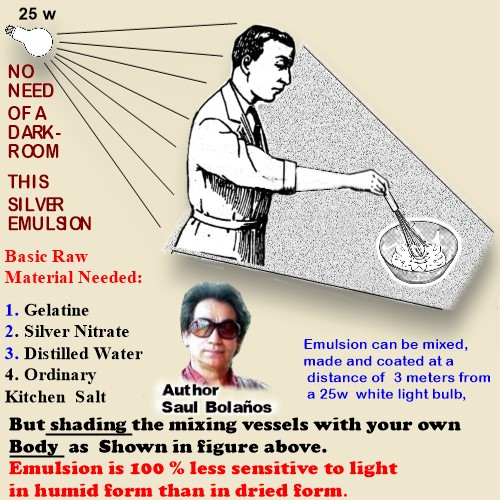 Formula To make
Formula To make
400 -500 ml of finished emulsion
This “contact printing speed” silver chloride emulsion is simple and rapid to
prepare, it can be made at night at 8 feet (2.5 mts) under the light of a 25 w incandescent bulb, shading vessel with
the body.
If amount of gelatine is reduced in A, contrast will lower giving a coarse
grain with tendency to fog on development. Vigorous agitation during precipitation is vital for good contrast.
At 50c, (122f) water evaporates at such a slow rate,
that for the time given for its ripening 30-40m/50c Emulsion can
be mixed, made and finished in 1 liter glass bowl, with no need to transfer to other vessels with a lid.
At the my Research Labs,
looking at the files now, I found I formulated, in a 20 years span of time, more than 200 washed and unwashed silver
chloride emulsions, research was systematic. The formulas chosen to be given here are the easiest to make with the
assurance to obtain good results. This formula will furnish a good emulsion
even with the
worst of “food grade” edible Gelatines.
With ripening time of only 30m /50 to avoid any fog. It gave whites with powdered
edible gelatines (never as pure and clean as other edible gelatines in leaf form) but it was acceptable, the blacks
were solid. Inert type of gelatines, which because lack of sulphur do not give strong
solid blacks with bromide emulsions, will furnish good blacks with this chloride emulsion.
If coated on
Chemically inert materials like 100% rag or cotton watercolor paper the present emulsion will keep for years without
fog, sealed from air humidity and contaminants, inside light tight plastic bags, kept below 27c.
EMULSION FOR MULA
------------------------------------------------------------------------------
A. Salts Solution Heated to 50c
(122 f )
Dissolve in order given:
Distilled Water ................................................300 ml
Sodium chloride ( ordinary kitchen salt) ... 5 gram
food grade LEAF gelatin colorless.............40 gram
----------------------------------------------------------------------------
B. Silver Solution, use at room temperature
Distilled Water..................................................100 ml
Silver Nitrate .................................................10 gram
C. Antiseptic:
Salicylic is optional. To keep liquid uncoated
emulsion without mould for 1 year or so under refrigeration.
10% salicylic acid in alcohol
...............................10 ml
ethyl alcohol (for easy flowing of emulsion) ..10 ml
D. Gelatine
Hardener to prevent gelatine damage during processing:
5 % potassium Alum solution................................ 8 ml
EMULSION DATA
1. 45 % Halide
(salt) in excess
2. Ratio Ag / Gel 1:4
3. Ripening
temp: minimum: 30/40 min /50 c
never go above 60c with this emulsion it will fog
!
for normal speed and contrast, grade 4.0 It can
be heated up to 90 min/ 50c without fog. in 90/min 50c
speed will double but grain will grow, and contrast may
drop tograde 3.0 (which is also high) but tones
are not as warm
on development.
PRECIPITATION
B/ in A/ in 5 seconds or
less
+ Agitate briskly 1 minute.
+ 30 minutes 50c. ( 122 f)
Stirring 15 secs every 10 min
+ C/ stir well to homogenize mix
+ D/ optional (but recommended )
emulsion is finished just add tap water to final Volume:
which should not be more than 500 ml for a normal 8
% gel conc.
it can be 400 - 425 ml for a thicker 10 % gel conc.
Chloride Warm Tone Unwashed Positive Emulsion # 4 Graphic steps
How To make 0.5 liters of finished emulsion. STEP 1 By room temperature soak the gelatin (cut in small pieces if in leaf form) in the
 cold salts solution until it becomes limp and flexible, stir about a minute to wet at all
point as much as possible. Leave soaking at least 15 minutes before melting.
cold salts solution until it becomes limp and flexible, stir about a minute to wet at all
point as much as possible. Leave soaking at least 15 minutes before melting.
STEP 2
After soaking, melt gelatine in salts solution in hot water bath at 50c.( 122 f ) stir with a plastic spoon. Once
completely melted and at 50c , in darkroom by bright yellow artificial light, precipitate as in next step 3.
STEP 3
PRECIPITATE With salts bowl inside
water bath at 50c , add silver sol rapidly in less than 5 secs while stirring briskly with wire beater. Continue
agitation for 60 more seconds after precipitation . After that, continue heating at 50c, for 30-40 min agitating for 15
seconds every 10 minutes. At the end of 30-40 min, stir in antiseptic C,
followed by
hardener D,
adjust final volume with water to no more than 500 ml for a “normal” gel
concentration of 8 % At this concentration emulsion will be thin enough for coating large areas for example a paper
sheet size ( 20x24 inches)
without prematurely coming in its solid form. especially in cold weather, below 22c. If very small areas are to be
coated, for example 25 x 25 mm (1x1 inches) and room temperatures are above 23-24c, (73-76 f) In this case do not add
any water, to cause the applied emulsion to set more rapidly.
Finished emulsion can be coated immediately after mixing, or stored under refrigeration for long keeping in liquid
form. Before refrigerating, let emulsion mature at room temp for at least 24 hours, to let reactants accommodate and
find their own equilibrium during that time. Emulsions are very sensitive to temperature shocks. After keeping under
refrigeration (or at room temp) for any period of time ,
on re-melting and coating, if paper is exposed and
processed immediately after coat has dried, speed will usually be about 100% lower, if processed 24-48 hrs after
coat has dried, speed will be at a maximum and so will contrast.
For processing and Working of this CONTACT SPEED excellent Multi -Tone Emulsion
under the illumination of an ordinary 25 watt incandescent while light bulb, (or a bright yellow bulb) See next pages.
Tones on development may be from rich blue black , brown black, to sepia and even brick red tones on diluted restrained
developers with increased exposure. Hardening Stop Bath for Processing “All Types” of my Emulsions
Boric - Aluminum Hardening Stop Bath
SOLUTION A
Prepare a 5 % Boric Acid solution by dissolving:
boric acid 5 grams
mixture of water and alcohol 1:1 20 ml
rub into a paste and dissolve in boiling water 90 ml
--------------------------------------------------------------------------
SOLUTION B
Prepare a 5 % Aluminum Sulphate solution:
Aluminum Sulphate 5 grams
warm water 100 ml
----------------------------------------------------------------------
For use, mix equal parts of A and B. This is
another contribution of my labs to darkroom photography, After I formulated this bath, the use of a hardening fixer, to
avoid damage of emulsion during washing, was no longer necessary.
on mixing the 5% solutions of boric acid with the 5%
solution of aluminum sulphate, a permanent white precipitate is formed. The bath is stirred every time right before
use, it is permanently milky. The clear solution above the white precipitate has hardening power as it does the milky
sediment of aluminum hydroxide.
If milky deposits are formed on surface of emulsion (glass plates) they are simply rinsed off with a wet ball of
cotton. my emulsions processed with this bath as far as 20 years back, are in excellent condition now.
It is a bath
for archival permanency. The bath has incredible capacity, during immersion of emulsion in it, the hardening action can be felt with the fingers on the emulsion itself, which on hardening
looses its “slippery” condition which is typical of swollen soft gelatine. The
slippery feel is lost within 5 to 60 seconds, (depending on freshness of bath) emulsion on hardening will feel like
hard leather.
After immersion, a 10 seconds rinse in plain water is recommended, followed by immersion in a regular “non hardening”
acid fixing bath. The official immersion time is this bath is no less than 30 seconds with continuous agitation. When
hardening action takes longer than 1 min, ( as felt by the fingers) discard and prepare a fresh bath. If the Boric Acid
is not first rubbed into a paste with cold alcohol and water, as directed, before it is added to the hot water, the
acid will not dissolve and most of it will remain in suspension in the solution.
As given, it is the correct way to
dissolve boric acid for any purpose. Solution keeps indefinitely.The aluminum
solution may be permanently a little milky due to formation of compounds in tap water, which is normal and does not
affect performance. Solution keeps indefinitely.
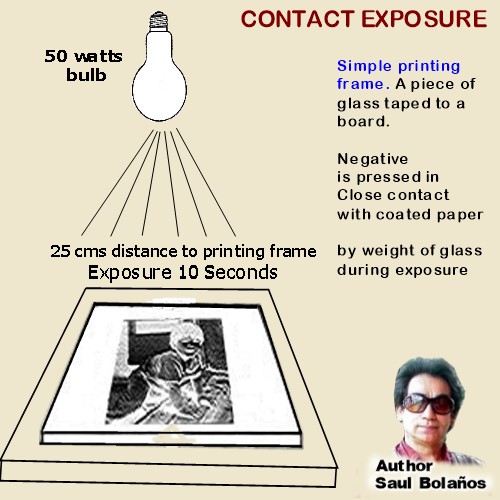 Contact Speed
Contact Speed
of this Chloride Unwashed Positive Emulsion # 4
IMPORTANT DURING THIS STEP:
protect any other coated material from accidental light exposure. All other coated material
should be enclosed safely in light proof bags boxes or containers before turning on white light to make the exposure.
This step is a frequent cause of loosing coated paper by fog.
CONTACT EXPOSURE
as in figure, with the negative in contact with the coated paper or material
under the glass of a printing frame,
and the contact printer (which see) placed directly under the light of a 50w
ordinary incandescent bulb, at a distance of 25 cms (10 inches) Light Exposure time should
be around 10 seconds,
This exposure time is for a black tone, and developing time
of around 30 - 45 seconds, in Dektol or D72 type of developer diluted 1:2 with water at 20c /68 f.
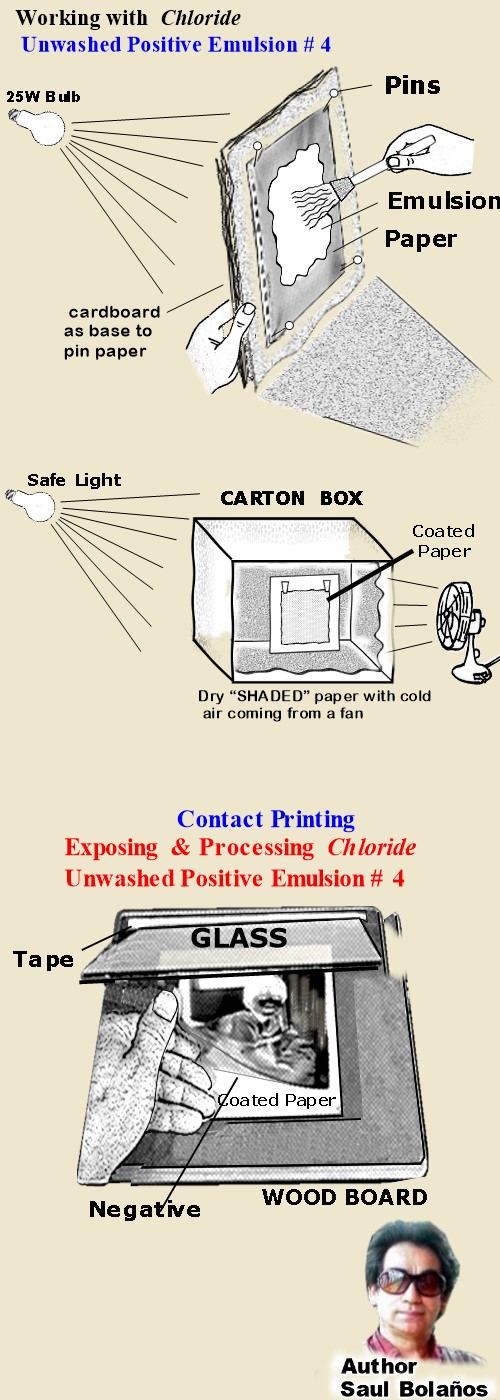 For General Processing Steps of this Emulsion, see also my chloro-bromide unwashed Emulsion # 2, see there also
formula of D72;
For General Processing Steps of this Emulsion, see also my chloro-bromide unwashed Emulsion # 2, see there also
formula of D72;
-a Metol Quinone ( MQ) Dektol type of paper developer.
Coating Paper
In Darkroom, with emulsion melted at
around 35- 38c, Pin paper to be coated on a pile of newspapers, and place it in a manner that is not hit directly by
the light , as shown in fig. Where the pile of newspapers or cardboard act as wall protecting the emulsion from
excessive “safe” light exposure which will degrade the whites on development. Alternatively, during coating, shade the
paper with your own body as shown previously. emulsion may be coated directly on watercolor fiber paper, For better
blacks Apply 2 brush coats of my clear sub #1 (which see) to the paper. After sub has dried, apply 2 to 3 thin brush
coats of emulsion
Exposing & Processing
Chloride Unwashed Positive Emulsion # 4
Place the coated paper in firm contact with a silver negative produced on glass or celluloid, Make a contact printer as
shown in figure, tape a piece of glass to a board. Lift the glass, place the coated paper on the baseboard, on top of
the sensitive paper, place the negative, lower the glass in a manner that its weight firmly presses the negative in
close contact with coated paper.
Make the exposure to white light. (as in figure) The glass in the printing frame will
let the light go through while at the same time pressing the negative against the paper for sharp lines on the
developed image.
Instead of a silver negative. A DIGITAL negative (made by computer/ printed on acetate) can be used. (see ahead) The final size of the image will
be the same size as the negative employed.
Make the Exposure Expose the negative in contact with the paper to white the light. At the
end of exposure; -Separate negative from the light sensitive coated paper, and then develop the exposed paper. The
negative of course can be used again for a infinite number of times especially if it is on glass.
Drying Paper
Place coated paper inside an ordinary brown carton box. Place it AS SHOWN IN FIGURE, in a manner that paper being dried
inside of it, is not hit directly by the safelight. Paper shaded in this manner, can be left to dry as long as it is
necessary without risk of safelight fog. To dry, direct Cold air from a fan, emulsion will be firm enough in 5-10
minutes to receive second coat even if first coat is not completely dried.
Apply a third coat in same way if necessary.
After drying pack away safely. in total darkness in a dry cool place (see shelf life of coated material) it keeps a long
time.Expose and process.
Emulsion Capacity / Brush Coated:
1 Liter covers about 100 sheets of Fiber Paper size (20 x 25 cm) 8 x10
in. Sensitivity to the white “Safe” Light of a 25w incandescent bulb: 2 minutes. At 8 feet distance Dry coated paper
will begin to show fog on development with an exposure of 2 minutes.
It must not be exposed directly longer to 1 minute
to that light. For Safer Light use a 25 w Bright Yellow bulb. In a humid condition coated emulsion can stand double
exposure times given without fog.
For Soft Contrast Blue Black Tones:
Expose to Develop in about 45 seconds 20-23c in undiluted Developer like Dektol or D72. Developing times longer than 60 seconds only increases fog. Very soft prints are obtained in this way, it may be useful when printing from digital negatives produced on acetate film. A plain developer made of: Metol 5g, sodium sulphite 50g, Water 1 Liter, will also Lower Contrast.
 Processing
Processing
1. DEVELOP 30 - 45 seconds for blue black tones or 2 -6 min for brown to sepia tones.
2. STOP BATH
Transfer to a 1 % acetic acid stop bath for 30 seconds. If there is damage here or during washing use my Bor Alum Hardening stop bath (which see) for 30-60 secs, With this excellent stop bath, a plain non hardening fixing bath can be used below.
3. FIX
for no more than 10 minutes In a “hardening” fixer (if LUCENTA hardening stop bath is not used) with frequent agitation. For Archival Permanency: 10 min / 2 baths First Bath: 5 minutes this bath can be a used bath (but not overworked) Second Bath: 5 minutes, bath must be fresh and unused.
4. WASH
30 minutes to 1 hour (for heavy papers) in gently running water. Developing for Brown Black Tones Expose 100 % more than for black tones. Develop for 4 - 6 min at 23 c in: Dektol or D72 (see formula) 1:2 70 ml 10 % solution of Citric Acid 10 ml.
Extra warm tone Hydroquinone developer
for My Chloride and Cloro-Bromide emulsions. Hydroquinone Developer With Overexposure: 4X For Red Brown To Sepia Tones in about 8 Minutes.
Keeping A and B in Separate solutions in a full bottle, A keeps 6 months or so. B, keeps indefinitely. for Use: mix equal parts of A and B. For very warm tones: dilute the mixed developer with 10 parts of water and overexpose 4x (compared to minimum exposure required for black tones) and increase development time.
For example, with a 4x exposure (1:10) image starts appearing in about 3 min/ 23c, and taking to a final development time of 8 min, silver chloride or silver cloro-bromide emulsions will furnish Red Browns, Chocolate to rich sepia tones. With 10-12 x exposure and increasing development time even further: Brick Red Tones are obtained.
Extra Warm Tone Hydroquinone developer
Sol A
Hot Water 500 ml
Sodium Sulphite 25 gram
Hydroquinone 6 gram
Sol B
Hot Water 500 ml
Sodium Carbonate 25 gram
Potassium Bromide 2 gram
Both Sodium Sulphite and Sodium Carbonate are ANHYDROUS Salts.
Ortho-Cromatization with Erytrosine of my Chloride & Cloro-Bromide Emulsions.
add per Every 100 ml of Emulsion:
Emulsion Melted at 35-40c 100 ml
1: 500 solution of Erytrosine 1. 5 ml
Optional: 2 .5% solution of Tartrazine 3 ml
Erytrosine 1:500
FORMULA OF DYE SOLUTION:
Erytrosine dye 1 gram
distilled water 250 ml
Ethyl Alcohol 250 ml
Solution keeps indefinitely specially if under refrigeration and away from Strong Daylight.
solution above will triple or at least double original speed of “finished” emulsion. introduce it at the end of ripening before coating with good agitation. The dye will stain Silver Chloride and Silver Bromide to “see”yellow and green radiations.
Useful when printing by contact from color negatives on acetate. All the color in the original will be rendered (except the red) as the human eye see it, but translated to grays. Handle emulsion under Dark Red light only, to avoid fog after Ortocromatization. If Potassium Bromide is added to stabilize, added after staining, not before otherwise the power of Erytrosine will be much reduced or entirely ineffective.
More quantity than the above given can be added for extra speed, but the red stain of the dye on paper, will take too long to wash out or will not do so completely.
The pink stain left by the dye on emulsion coated on glass plates, can wash out easier than on paper. Erytrosine is used as a “Food Coloring Dye” it can be obtained easy, it is also used by all microbiology labs in the world. To really intensify the “Ortho” effect of erytrosine stained emulsion, expose under a yellow filter. Alternatively add the filter directly to emulsion in form of a yellow dye like tartrazine given above, tartrazine is non toxic Food Coloring Dye that washes out gelatine extremely easy
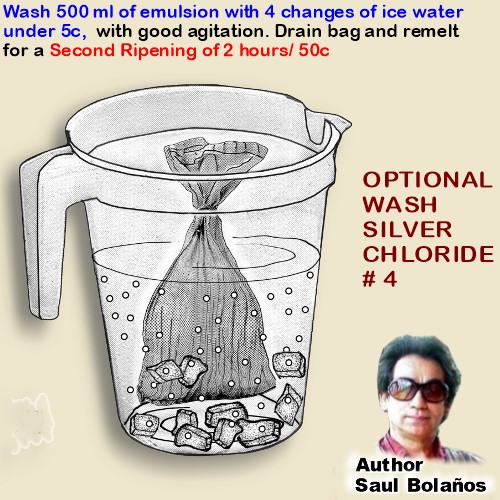 Washing Chloride Emulsion # 4
Washing Chloride Emulsion # 4
For full particulars on how to wash emulsions, see chapter 4
on Washing. It is not necessary to go through the trouble of washing emulsion # 4. Unwashed emulsion can also be coated on glass with due regards to certain precautions on packing and storing as given in CHAPTER 6 “Coating 35 mm Glass Plates” which see.
Wash to have an extremely clean non hygroscopic coatings on glass plates In which case following Washing Data Applies, after First Ripening at 30m/50c, do not add the salicylic acid and the potassium alum because they will wash out. Wash with 4 changes of water, 2 liters each change, Each change lasting 5-10 min with very good agitation.
After washing melt and Second Ripen for 2 hours at 50c, At the end of that time speed will double or triple, and per every 400-500 ml of Emulsion stabilize with 4 ml of 10 % citric acid and add finals, coat or store emulsion under refrigeration to ortocromatize proceed as follows:
ORTOCROMATIZATION
After washing At the end of Second Ripening of 2 hr /50c add: 10 % Citric Acid: 4 ml, stir, + 10 % Sodium Carbonate: 4 ml, stir + Erytrosine 1:500: 4 ml stir, now add the Alum and the Salicylic acid. Finished Emulsion will be 4 times More Rapid after above additions Wash 500 ml of emulsion with 4 changes of ice water under 5c, with good agitation. Drain bag and remelt for a Second Ripening of 2 hours/ 50c

Chloride Extra Slow Unwashed Positive Emulsion # 5
The rest of the formula as well as all manipulations and additions remain identical. Emulsion made with 15 % salt excess, produces “Extra Hard” contrasty images with very solid blacks on generous exposure, it can also provide lower contrast on normal exposure time.
Note: For a Reduced Light Sensitivity of about 6x, Ripen as usual for only 30min at 50c (122f) If Ripened for 4 hours at 50c, emulsion will gain the sensitivity of that given by emulsion with 45% salt excess ripened for 30m/50c. With this emulsion 3 hours at 50c is equivalent to only 1 hour at 60c. Never ripen chloride emulsions at 65c the Silver Chloride will decompose ( Fog ) for this slow smulsion ONLY the salts solution A is modified to have have less kithen salt. All other solutions remain the same.
----------------------------------------------------------------
A. Salts Solution 15 % Salt Excess
Heated to 50c (122 f ) Dissolve in order given
Distilled Water 300 ml
Sodium chloride (ordinary kitchen salt) 4 gram
flavorless and colorless gelatine 40 grams
-----------------------------------------------------------------
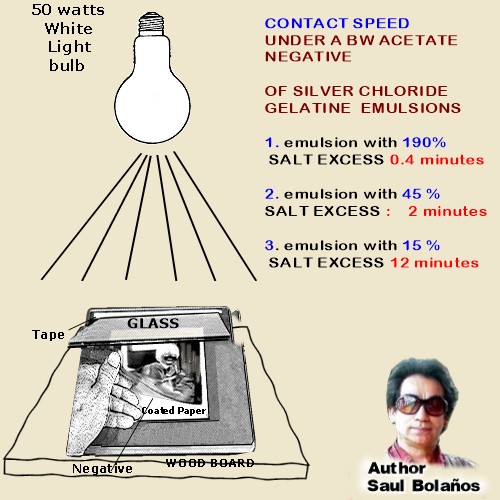 Compared Light Sensitivity
Compared Light Sensitivity
of the 3 Different Chloride Emulsions.
CONDITIONS:
Dry Emulsion coated on paper and exposed at 3 meters (10 feet) distance from an ordinary 50w incandescent white light bulb. All Emulsions Ripened for 30 min at 50 c. and made with same type of Food Grade gelatine
(gelitas: se chapter 2) in Leaf Form Relative speed all conditions being equal, is shown below:
1. Chloride unwashed emulsion with 190% excess Sodium Chloride: 0.4 minutes
2. Chloride unwashed emulsion with 45% excess Sodium Chloride:
2 minutes
3. Chloride unwashed emulsion with 15% excess Sodium Chloride:
12 minutes
It follows then than the Third Emulsion can be made, coated, and processed in Rooms with much Brighter illumination without the Risk of Fog on Development.
Contact Printing Speed
Exposure under a Bw silver negative
at 25 cm distance / 50w incandescent white Light bulb:
First Emulsion: 2 seconds
Second Emulsion: 10 seconds
Third Emulsion: 60 seconds.
Notes:
contrast is a little lower on rapid emulsion, which due to large grain size does not give very warm tones on developing so easy, as do the others with a finer silver grain which have also more covering power than larger silver grains.

Rapid Chloride Unwashed Positive Emulsion # 6
(5 Times faster than # 4 ) Formula To Make 250 ml of Finished Emulsion
in Darkroom By bright Yellow Light Emulsion can be mixed in a 500ml glass bowl, stir with a stainless steel wire beater. Prepare, Mix, Coat , Dry , Store , Expose and Process as already directed for My unwashed Emulsion # 4. If exposed in humid form (coat not dried but firm enough) increase exposure by 50 %
COATING CAPACITY:
250 ml emulsion will coat about 30 paper sheets size 20 x 25 cm (8x10 in ) Covering Power: good with 3 brush coats on preferably subbed watercolor paper Silver Chloride emulsions are not rapid, The fastest ever made were dosed with sensitizing dyes and made with the presence of iodide.
The most rapid silver chloride emulsions in history, were made by the author at his Research labs. This ultra rapid enlarging speed Chloride emulsion were made with “his Rapid Gelatine“. This is Gelatine that was purified by a complex process worked out in my Labs. After purification the gelatine was dosed artificially with great amounts of sulphur for speed and dosed with precise amount of organic retarders to check fog.
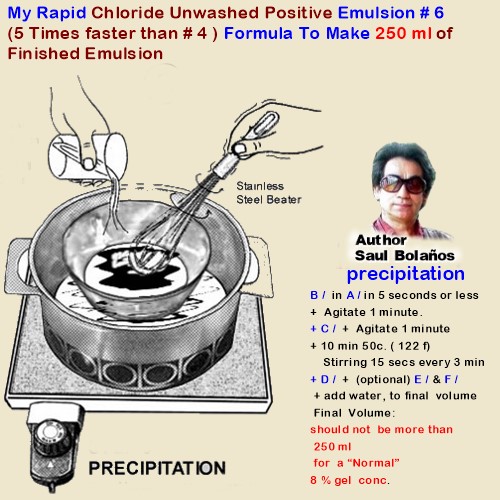 The Present Chloride emulsion
The Present Chloride emulsion
can be made with any gelatine (if " food grade” use leaf form) , It gets its speed by a crafty precipitation technique alone in combination with a great excess of salt ( 190 %) to induce rapid grain growth. The high silver content is to impart not only speed but also covering power.
The citric acid increases contrast and reduces fog and also the great of amount of gelatine in Sol A.
Reducing gelatine content results in a lot more speed, but with very bad covering power.
Ripening time is of capital importance.
At 60m/50c: paper is more rapid but does not keep well during storage.
With only 30m/50c Ripening time, paper is 100% less rapid, whites are clean but never as clean as Ripening time of only 10-15 minutes which is the time recommended where coated paper keeps many months on storage without signs of fog.
Contrast is high,
about grade 3. Fast enough to be printed by projection,
for example onto stones or eggs which have been coated with the same emulsion; A 2x enlargement, (silver neg/ bulb incandescent 100w / lens aperture F 4) exposure is about 1 minute In same conditions, if it is projected 1:1: (but not enlarged) exposure is about 20 seconds.
------------------------------------------------------------
-----------------------------
FORMULA
A. Salts Solution Heated to 50c (122 f ) Dissolve in order given
Distilled Water 90 ml
Citric Acid 2 gram
Sodium chloride (ordinary kitchen salt) 2 gram
flavorless and colorless gelatine 20 grams
B. Silver Solution, use at room temperature
Distilled Water 90 ml
Silver Nitrate 10 grams
C. Extra Salt Solution, use at room temperature
Distilled Water 40 ml
Sodium chloride (ordinary kitchen salt) 8 grams
D. Stabilizer to stop ripening, Citric Acid: 1 gram
water 10 ml
E. Antiseptic: Salicylic is optional. To keep uncoated emulsion without mould for 1 year or so under refrigeration
10% salicylic acid in alcohol 5 ml
ethyl alcohol (for easy flowing of emulsion) 10 ml
F. Gelatine Hardener to prevent gelatine damage
during processing: 5 % potassium Alum solution 4 ml
------------------------------------------------------------------------------------------
Precipitation
B / in A / in 5 seconds or less
+ Agitate 1 minute.
+ C / + Agitate 1 minute
+ 10 min 50c. ( 122 f)
Stirring 15 secs every 3 min
+ D / + (optional) E / & F /
+ add water, to final volume Final Volume: should not be more than 250 ml for a “Normal” 8 % gel conc.
EMULSION DATA
1. About 190 % Halide (salt) in excess
2. Ratio Ag / Gel 1:2
3. Ripening : For Clean Emulsion maximum 10 min 50 c
It can be heated up to 30 m/ 50c without much fog. Speed will double but grain will grow, and contrast may lower to grade 2.5, emulsion will not will be very clean with tendency to fog on storage.
 Relative Enlarging Speed Comparison
Relative Enlarging Speed Comparison
of 6 different of my Positive emulsions given in this book
/ without orthocromatization.
All using the same type of Food Grade edible gelatin(Gelitas-see chapter 2) in Leaf form.
This gelatine is inert, inactive, and must be dosed with sulphur to give maximum speed and strong blacks for the bromo-iodide emulsion (# 1 below). With all other pure chloride and chloro-bromide emulsions, however, sulphur was not added because it is not found necessary to furnish speed and strong blacks. Identical Conditions of testing and Exposure times see below .
EMULSION NUMBER: 2 x Enlargement.
see conditions below FOR EXPOSURE:
# 1 Amoniacal washed Bromo-Iodide with no First Ripening 5 seconds
# 2 Cloro-Bromide unwashed 170 % salt excess normal silver content. 10 seconds
# 3 Cloro-Bromide unwashed 170 % salt excess extra silver content 5 seconds
# 4 pure Chloride unwashed 45 % salt excess 5 minutes
# 5 pure Chloride unwashed 15 % salt excess 30 minutes
# 6 pure Chloride unwashed 190 % salt excess 1 minute
PAPER DEVELOPER D 72
This developer is identical a kodak’s Dektol, it can also substitute Ilford’s Bromophen or Agfa’s Neutol paper developers.
FORMULA:
Water about 50c ( 125 f) 500 ml
Metol (or kodak’s Elon) 3 grams
sodium sulphite anhydrous 45 grams
Hydroquinone 12 grams
sodium carbonate monohydrated 80 grams
( If anhydrous use 67 grams)
Potassium bromide 2 grams
add cold water to make total 1000 ml
For all paper used diluted with 2 parts water.
Developing Time at 20c ( 68 f ) for bromide Emulsion # 1 for 1.5 minutes.
For Cloro-bromide Emulsions # 2 and # 3: 45 - 60 seconds
For Pure Chloride emulsions # 4, #5 and # 6: 30- 45 seconds.
 EXPOSURE CONDITIONS,
EXPOSURE CONDITIONS,
Enlargement: 2x / Light Source: ordinary incandescent 75 watt bulb / Lens open to f 4.0 / Same black and white medium density Silver negative for all tests.
Contrast All emulsions work very clean, the highest contrast 4-5, the Chloride emulsions, Chloro-bromide emulsions: # 2,
ripened at 45c yields a very high contrast grade way above 3.0 All others at least grade 3, definitively much higher contrast than “ normal” grade 2.0 Obviously the Chloride emulsions # 4 and # 5, are too slow for enlarging,
they are very suitable for contact printing to get extremely beautiful warm tones on development (see warm tone hydroquinone developer) Contact prints can be made from digital negatives, which printed by computer on clear acetate, can produce large format pictures with very short exposure times.
In case of digital negatives, a “ Soft “ developer may have to be used. The # 6 extra rapid pure chloride emulsion, can be used for enlarging. To reduce exposure,
a more powerful light source, with ventilation, may be used. That in combination with a rapid camera lense ( in case of 35mm negatives) of f 2.8 can cut exposures substantially. It may also be orthocromatized with erytrosine in which case it will gain 100- 200 % more speed.
NEXT
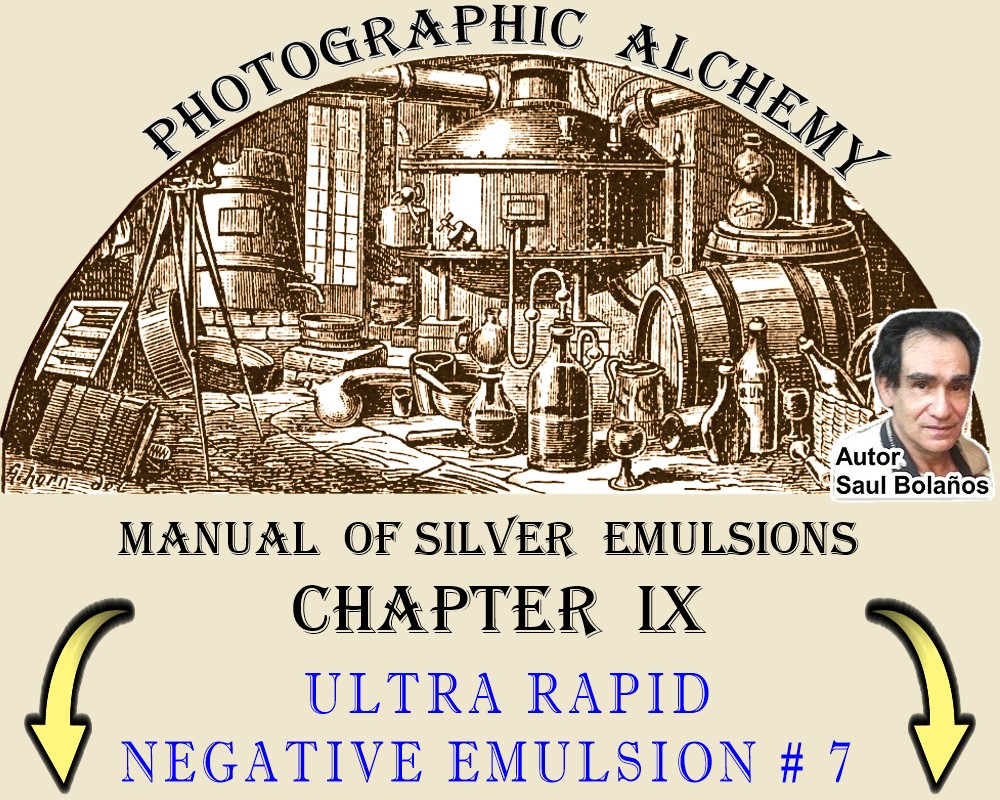
CHAPTER 1
BRIEF EMULSION SPEED HISTORY
CHAPTER 2
GELATINE FOR PHOTOGRAPHIC SILVER EMULSIONS
CHAPTER 3
ELEMENTAL SILVER BROMIDE CHEMISTRY
CHAPTER 4
WASHING OF GELATIN SILVER BROMIDE EMULSIONS
CHAPTER 5
AMMONICACAL POSITIVE EMULSION
CHAPTER 6
COATING GLASS AND PAPER WITH SILVER EMULSION
CHAPTER 7
CHLORO-BROMIDE POSITIVE EMULSIONS
CHAPTER 9
ULTRA RAPID NEGATIVE SILVER EMULSIONS
CHAPTER 10
SILVER EMULSION PROBLEMS AND SOLUTIONS
CHAPTER 11
FORMULAS FOR SUBS, SEPIA TONERS, VARNISHES
CHAPTER 12
PINHOLE PHOTOGRAPHY - CAMERAS WITHOUT A LENS
CHAPTER 13
HOW TO MAKE DIGITAL NEGATIVES IN COMPUTER
CHAPTER 14
HOW TO DEVELOP SILVER PRINTS WITH COFFEE
CONTACT

COSTA RICA © 2025, saul bolaños
CAFEDESAUL@GMAIL.COM